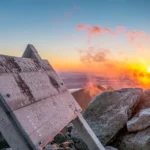Completely New to the Appalachian Trail?
If you’ve just learned what the A.T. is, we recommend reading through our general FAQ to help get you oriented to this national treasure!
How to Hike the Appalachian Trail
The Appalachian Trail (A.T.) is over 2,190 miles long, passes through 14 states, eight different national forests, six national park units and numerous state parks, forests, and game lands. But you don’t have to hike every mile of the Trail to experience its beauty (and toils). People enjoy the A.T. in a variety of ways! Here’s some common lingo.

Kemper Mills Fant



How is the A.T. Marked?
The A.T. is marked for daylight travel in both directions using a system of white “blazes,” or a rectangle of white paint 2 inches wide and 6 inches high. Blazes are found most often on trees, occasionally on posts and rocks.
Piled rocks called “cairns” are also used to identify the route above treeline. Side trails and shelter trails use blue blazes. Distance between blazes varies, but if you have gone a few hundred yards without seeing a blaze, stop. Retrace your steps until you locate a blaze. Then, check to make sure you haven’t missed a turn. When your map or guidebook indicates one route, and the blazes show another, follow the blazes.
In the 25 federally designated wilderness areas the A.T. passes through, blazing is intentionally much less frequent, and signage is minimal to retain the wilderness character of the land. Blazes may be 1/4 mile apart. Side trails may not be marked. Carrying a map and compass are especially important in these areas, found in Georgia through Virginia, and Vermont and New Hampshire.

Single White Blazes
White blazes mark the A.T. and may be located on trees, rocks, posts or guardrails, among other places.

Double White Blazes
Two white blazes, one above the other, signal an obscure turn, route changes, an incoming side trail or other situation that requires you to be especially alert to changes in direction. Sometimes the two blazes will be offset in the direction of the turn.

Rock Cairns
These rock piles identify the route above treeline and where snow and fog may obscure paints blazes.
Finding a Hike
At over 2,190 miles, there are literally thousands of incredible places to visit on the A.T.! Our free, interactive map is a great place to start planning your trip to the Trail.
Interactive Map
Getting to the Trail & Parking
The A.T. has hundreds of access points along its length where you can park and get on the Trail. These trailheads range from large, paved parking lots to small, dirt pull-offs. Most of the A.T. is in remote areas, but there are some public transportation options and shuttle services available.
Transportation & ParkingAccessibility
There are opportunities for every ability on the A.T. Find wheelchair accessible routes, multi-use sections, and more.
AccessibilityPermits & Fees
Some parts of the Trail require an entrance fee and permit, and some places require fees for camping.
Permits & FeesEssential Skills
Learn the essential skills every hiker needs to prepare for the Appalachian Trail and protect its landscapes. From navigation and safety to backcountry hygiene and responsible camping, these tips help you have a safe, enjoyable, and low-impact experience on the Trail.
Essential SkillsHiker Prep Series
Before heading out to the Appalachian Trail for your long-distance hike, check out our hiker preparation series for tips and checklists on how to have a safe and enjoyable A.T. experience.
Hiker Prep SeriesStewardship & Responsibility


Emma Getz
Register Your Hike – ATCamp
Planning an overnight, multi-day, group trip, or thru-hike of the Appalachian Trail? Register your hike using our ATCamp registration to help you choose a date and starting time that will help you avoid crowded trailheads and campsites.

Report an Incident
While the Appalachian Trail is a relatively safe place to visit, that does not mean that there are not potential dangers while you are hiking or camping. If you see something, say something — this will help us keep the A.T. as safe as possible for our visitors.
Report an Incident

